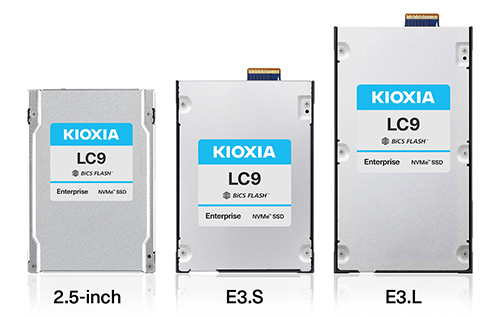The KIOXIA LC9 series has become the highest capacity PCIe 5.0 enterprise SSD; Adopting 32 layer stacked BiCS FLASH (TM) QLC 3D flash memory
Kioxia Corporation has expanded its high-capacity KIOXIA LC9 series enterprise grade SSD product line, launching the industry's first 245.76 terabytes (TB) NVMe ™ SSD, We offer two specifications: 2.5-inch and EDSFF E3. L. This new capacity and specification option complements the previously released 122.88 TB (2.5-inch) model, designed specifically to meet the performance and efficiency requirements of generative AI environments.

KIOXIA LC9 series enterprise grade SSD (specification: 2.5-inch E3.S、E3.L)
Generative AI has unique storage requirements, including the need to store massive datasets for training large language models (LLMs), as well as create embedded vectors and vector databases to support inference achieved through retrieval enhanced generation (RAG). These workloads require storage solutions with excellent capacity, speed, and efficiency.
The KIOXIA LC9 series SSDs use 32 layer stacked 2 terabits (Tb) [3] BiCS FLASH ™ QLC 3D flash memory, combined with innovative CBA (CMOS direct bonding to array) technology, can provide the speed, scale, and density required to support the next wave of data center workloads. This advanced storage architecture, combined with CBA technology, achieves a capacity of 8 TB [3] in a 154 ball grid array (BGA) small package, which is also an industry first [1]. The achievement of this milestone is attributed to Kioxia's high-precision wafer processing, material design, and wire bonding technology.
The KIOXIA LC9 series SSDs are highly suitable for data lake scenarios, where large-scale data ingestion and fast processing are crucial. Unlike hard disk drives (HDDs), which often become performance bottlenecks and result in expensive GPUs being underutilized, KIOXIA LC9 series SSDs can achieve high-density storage in a compact space with higher capacity per watt. With a capacity of up to 245.76 TB, they can replace multiple high-power HDDs, providing better performance, lower overall power consumption, occupying fewer drive slots, and achieving more efficient cooling. These features help reduce total cost of ownership (TCO) in terms of power consumption, density, and thermal management.
The features of KIOXIA LC9 series SSDs include:
• SSD capacity up to 245.76 TB, available in 2.5-inch and E3. L specifications
The E3. S specification has a capacity of up to 122.88 TB
• Designed to comply with PCIe ® 5.0 standard (up to 128 GT/s Gen5 single x4, double x2)
• Supports NVMe ™ 2.0 NVMe-MI ™ 1.2c specification
• Support Open Compute Project (OCP) data center NVMe ™ SSD 2.5 specification (not all requirements)
• Supports Flexible Data Placement (FDP) functionality to minimize write amplification and extend SSD lifespan to the greatest extent possible [4]
• Security options: Supports SIE, SED, FIPS SED
• Adopting the CNSA 2.0 signature algorithm [5], the design takes into account future quantum security standards
The KIOXIA LC9 series SSDs have started providing samples to some customers and will be showcased at the Future of Memory and Storage 2025 conference held in Santa Clara from August 5th to 7th.
Note:
1: As of July 22, 2025, according to Kioxia survey.
2: SSD capacity definition: Kioxia Corporation defines kilobytes (KB) as 1000 bytes, megabytes (MB) as 1000000 bytes, gigabytes (GB) as 1000000000 bytes, terabytes (TB) as 100000000000 bytes, and kilobinary bytes (KiB) as 1024 bytes. However, computer operating systems use the power of 2 to report storage capacity, which is 1GB=2 ^ 30 bytes=1073741824 bytes, 1TB=2 ^ 40 bytes=1099511627776 bytes, so the displayed storage capacity is relatively small. The available storage capacity (including examples of various media files) will vary depending on file size, format, settings, software and operating system, and/or pre installed software applications or media content. The actual formatted capacity may vary.
3: The calculation method for flash capacity is 1 terabit (1 Tb)=1099511627776 (2 ^ 40) bits, and 1 terabyte (1 TB)=1099511627776 (2 ^ 40) bytes.
4: Regarding RocksDB, Kioxia confirms that they are using a plugin (a feature extension program published on their Kioxia GitHub account). website: https://github.com/kioxia-jp/ufrop )When the FDP function is enabled, the write amplification factor (WAF) is approximately 1.1.
5: The KIOXIA LC9 series SSDs support the Leighton Micali Signature (LMS) algorithm recognized by CNSA 2.0 (Commercial National Security Algorithm Suite 2.0) as a digital signature algorithm to prevent firmware tampering and prepare for the threat posed by quantum computers to traditional cryptographic algorithms. The data encryption algorithm used by KIOXIA LC9 series SSDs, the Advanced Encryption Standard (AES-256) with a key length of 256 bits, has also been recognized by CNSA 2.0.
2.5 inches refers to the specification size of the SSD, not its actual physical size.
The read and write speed may vary due to various factors such as host devices, software (drivers, operating systems, etc.), and read and write conditions.
Performance data is preliminary and subject to change without prior notice.
Provide security optional models that support Instant Erasure (SIE), Self Encrypting Drive (SED), and FIPS (Federal Information Processing Standards) SED.
Due to export and local regulations, safety optional models are not available for sale in all countries.
NVMe and NVMe MI are registered or unregistered trademarks of NVM Express, Inc. in the United States and other countries.
PCIe is a registered trademark of PCI-SIG.
Other company names, product names, and service names may be trademarks of third-party companies.


